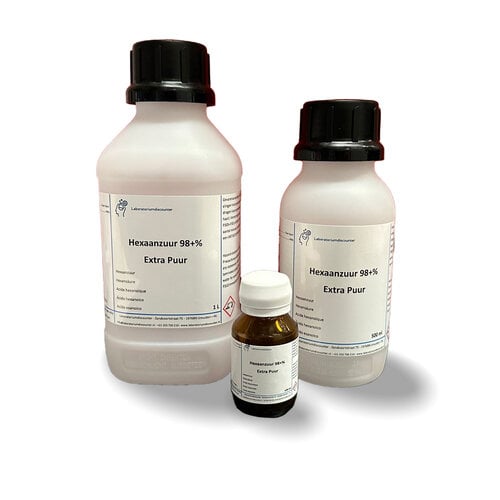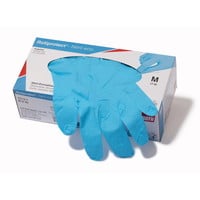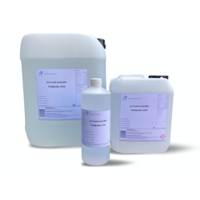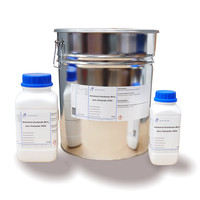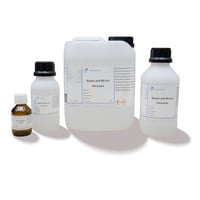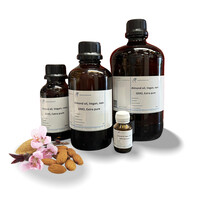You have no items in your shopping cart
Hexanoic Acid 98+% Extra Pure
- Buy 2 and save 5%
What is Hexanoic Acid?
Caproic acid, also called hexanoic acid, is a saturated fatty acid with the chemical formula C6H12O2. It is named hexanoic acid because of the six carbon atoms in its molecule. It has structural formula is C6H12O2. Caproic acid occurs in certain natural sources, such as coconut oil and goat's milk, and gives these substances their characteristic (unpleasant) odor and taste. It is also used in the food industry and cosmetics for its aroma. Sometimes it is used as a flavoring agent in foods and it is also used in the production of esters for fragrances and flavorings.
What is hexanoic acid used for?
Caproic acid has various applications in different industries due to its properties and aroma. A number of uses of caproic acid:
-
Food Industry: Caproic acid is sometimes used as a natural flavoring in foods. It can improve the taste of certain food products and is often used in flavorings for dairy products such as cheese.
-
Cosmetics and perfumery: Because of its scent, caproic acid or its ester is sometimes used in cosmetics and perfumes. It can be used in various cosmetic formulations, including lotions, creams and soaps, to add a pleasant scent.
-
Pharmaceutical Industry: In some pharmaceutical preparations, caproic acid is used as a component due to its antimicrobial properties. It can be used in skin treatment drugs and antimicrobial ointments. Please note that this caproic acid is not certified for this and may not be used for this purpose.
-
Chemical industry: Caproic acid is a precursor for the production of various chemical compounds. For example, it can be converted into caproic acid esters, which are used as fragrances and flavorings in food and perfumes.
-
Animal Feed: Caproic acid can be added to animal feeds as a feed additive to improve the taste and odor of pet food, making it more attractive to animals.
-
Chemical research laboratories: In laboratory settings, caproic acid can be used as a reagent or a standard for analytical chemistry and spectroscopy.
-
Industrial applications: Sometimes caproic acid is used in industrial processes, such as in the production of plastics, plasticizers and lubricants, although this is less common than some other acids.
- Other uses: Hexanoic acid is sometimes used in combination with ammonium bicarbonate and lactic acid to repel mosquitoes.
How is Hexanoic acid made?
Hexanoic acid, also known as caproic acid, is usually produced by oxidizing hexanol, an alcohol with six carbon atoms. This process involves adding oxygen to hexanol, often using an oxidizing agent such as potassium permanganate (KMnO4) or air. A catalyst, usually a metal such as cobalt, manganese or copper, can be used to speed up the reaction.
After the oxidation reaction, the reaction mixture is separated to isolate hexanoic acid. Impurities and byproducts are removed, and the hexanoic acid can be further purified by distillation or other purification methods.
Finally, the caproic acid can be concentrated to the desired concentration depending on the intended use. The manufacturing process may vary depending on the manufacturer and purity and concentration specifications.
Is hexanoic acid dangerous?
Caproic acid, also known as hexanoic acid, is generally not very hazardous to human health when used in accordance with normal safety precautions and in usual applications. It is a naturally occurring fatty acid found in small amounts in foods such as coconut oil and goat's milk and is commonly used in the food industry as a flavoring agent and in the cosmetic industry as a fragrance.
However, there are some important considerations:
-
Irritation: Like many other acids, caproic acid can cause irritation of the skin and mucous membranes when used in concentrated form. On contact with the skin it may cause redness, itching or a burning sensation.
-
Inhalation: Inhalation of caproic acid vapors or aerosols can cause respiratory irritation, so it is important to work in a well-ventilated area when handling concentrated caproic acid solutions.
-
Oral use: In small amounts such as those found in foods, caproic acid is safe for consumption. However, in concentrated form it can cause stomach upset and should be avoided.
-
Chemical Flammability: Caproic acid itself is not flammable, but it may become flammable in the presence of ignition sources.
It is always important to follow the safety instructions and guidelines provided by manufacturers of products containing caproic acid. If you plan to use caproic acid in a laboratory or industrial environment, it is advisable to wear appropriate personal protective equipment and follow safety precautions to minimize potential hazards.
What is the best way to store hexanoic acid?
Store caproic acid in an airtight container in a cool, dark and dry place, preferably at temperatures below 25°C. Make sure the container is tightly sealed to keep out moisture and light. Label the container clearly and avoid contact with incompatible substances. Inspect periodically for leaks or deterioration and keep out of reach of children and pets.
Buy hexanoic acid?
Buy hexanoic acid at Laboratory Discounter! Our hexanoic acid not only has a friendly price but is also of extra high quality! So you are guaranteed that you are getting a high-quality product. All our chemical products are packed and shipped in sturdy packaging, which minimizes the risk of breakage and means you can be assured that they will arrive intact. So if you want to order Caproic acid, you have come to the right place at Laboratory Discounter!
Technical information:
Hexanoic acid
Empirical formula C6H12O2
Molar mass (M) 116.16 g/mol
Density (D) 0.93 g/cm³
Boiling point (bp) 205 °C
Flash point (flp) 116 °C
Melting point (mp) -4 °C
ADR 8 III
WGK 1
CAS No. 142-62-1
EC No. 205-550-7
UN No. 2829
$$$$$
Hazard statements
H314 Causes severe skin burns and eye damage
Precautionary statements
Precautionary statements - prevention
P280 Wear protective gloves/eye protection
Precautionary statements - response
P303+P361+P353 IF ON SKIN (or hair): Take off immediately all contaminated clothing. Rinse skin
with water
P305+P351+P338 IF IN EYES: Rinse cautiously with water for several minutes. Remove contact lenses, if present and easy to do. Continuous rinsing
P310 Immediately call a POISON CENTER/doctor


